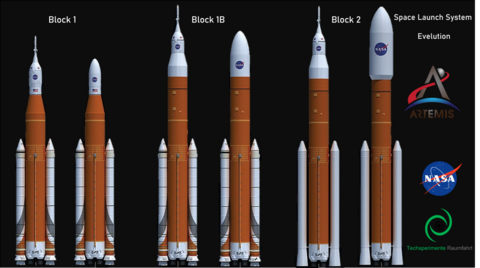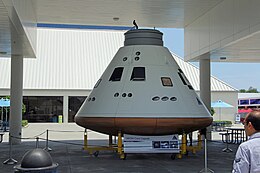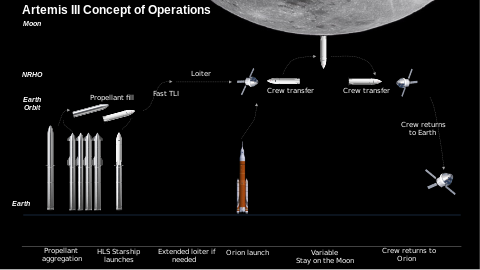Artemis 3
 Summary of the Artemis 3 mission plan | |
| Names | Exploration Mission-3 (2017–2019) |
|---|---|
| Mission type | Crewed lunar landing |
| Operator | NASA |
| Mission duration | ~30 days[1] |
| Spacecraft properties | |
| Spacecraft | Orion 004 Starship HLS |
| Manufacturer |
|
| Start of mission | |
| Launch date | September 2026 (planned)[4] |
| Rocket | SLS Block 1(Orion)[5] |
| Launch site | Kennedy Space Center,LC-39B |
| Contractor | NASA |
| End of mission | |
| Landing site | Pacific Ocean(planned) |
| Moonlander | |
| Landing site | South polar region |
Artemis 3(officiallyArtemis III)[6]is planned to be the first crewedMoon landingmission of theArtemis programand the first crewed flight of theStarship HLSlander.[7]Artemis 3 is planned to be the second crewed Artemis mission and the first American crewed lunar landing sinceApollo 17in December 1972.[8]In December 2023, theGovernment Accountability Officereported that the mission is not likely to occur before 2027;[9]as of January 2024, NASA officially expects Artemis 3 to launch no earlier than September 2026 due to issues with the valves inOrion's life support system.[4][10]
In August 2023, due to delays in the development ofStarship,NASA officials expressed an openness to flying Artemis 3 without a crewed landing.[11][12]In this case, the mission may become a crewed visit to theLunar Gateway.[13]In April 2024, it was reported that alternative mission options being internally evaluated by NASA include a test of docking between Orion and Starship HLS in low earth orbit.[14]
Overview[edit]
The goal of Artemis 3 is to land a crew at theMoon's south polar region.[15]The mission would see twoastronautsland on the surface of the Moon for a stay of about one week.[16]It is also intended to be the first mission to land a woman and aperson of coloron the Moon.[17][18]While up to four astronauts would launch aboardOrion,only two would land on the surface aboardStarship HLS,with the others remaining aboard Orion. The two astronauts will conduct up to four spacewalks on the Moon's surface, performing a variety of scientific observations, including samplingwater ice.Before the Artemis 3 landing, some additional equipment will be pre-positioned on the surface, including anunpressurized roverfor astronauts to use during their lunar excursions. This rover will have the capability to be controlled remotely. Several permanently shadowed regions could be reached by short forays of 5 to 15 km (3.1 to 9.3 mi), well within the range of the rover.[19]
Crew[edit]
| Position | Astronaut | |
|---|---|---|
| Commander | TBA,NASA TBA spaceflight | |
| Pilot | TBA,NASA TBA spaceflight | |
| Payload Specialist | TBA,NASA TBA spaceflight | |
| Mission Specialist | TBA,NASA TBA spaceflight | |

Spacecraft[edit]
Space Launch System[edit]
The Space Launch System is asuper-heavy-lift launcherused to launch the Orion spacecraft from Earth to a trans-lunar orbit. This will be the final mission using the boosterSLS Block 1,the design used for the first three missions. Afterward, fromArtemis 4untilArtemis 8,missions will useSLS Block 1B,with a more capableExploration Upper Stage,and a cargo hold to transport other payloads.

Orion[edit]
Orion is thecrew transport vehicleused by allArtemis missions.It will transport the crew from Earth to lunar orbit, dock with Starship HLS, and return the crew to Earth.
Starship HLS, depot, and tankers[edit]

After amulti-phase design effort,on 16 April 2021, NASA selectedSpaceXto develop Starship HLS and deliver it tonear-rectilinear halo orbit(NRHO) prior to arrival of the crew for use on the Artemis 3 mission. The delivery requires that Starship HLS be refueled in Earth orbit before boosting to the NRHO, and this refueling requires a pre-positioned propellant depot in Earth orbit that is filled by multiple (at least 14[20]) tanker flights.[21]Two astronauts will transfer from Orion to Starship HLS, which will descend to the lunar surface and sustain them for several days before returning them to Orion. Following the return of the astronauts, Starship HLS will be disposed of by sending it intoheliocentric orbit.[22]
Development[edit]
Upon the December 2017 ratification of theTrump administration'sSpace Policy Directive 1,a crewed lunar campaign – later known as theArtemis program– using theOrion Multi-Purpose Crew Vehicle(MPCV) and a space station in lunar orbit was established. Originally billed as Exploration Mission-3 (EM-3), the goal of the mission was to send four astronauts into a near-rectilinearhalo orbitaround the Moon and deliver theESPRITand U.S. Utilization Module to the lunar space station, known as theGateway.[23]By May 2019 however, ESPRIT and the U.S. Utilization Module – now called HALO – were re-manifested to fly separately on a commercial launch vehicle. Artemis 3, as it was now billed, was repurposed to accelerate the first crewed lunar landing of the Artemis program by the end of 2024, with a profile that would have seen the Orion MPCV rendezvous with a minimal Gateway space station made up of only the Power and Propulsion Element and a small habitat/docking nodewith an attached commercially-procured lunar lander known as the Human Landing System (HLS).[24]
By early 2020, plans for Orion and the HLS to rendezvous with the Gateway were abandoned in favour of direct docking of Orion and HLS, and delivery of the Gateway after Artemis 3.[25][26]
On 10 August 2021, anOffice of Inspector Generalaudit reported a conclusion that the spacesuits would not be ready until April 2025 at the earliest, likely delaying the mission from the planned late 2024 launch date.[27]Prada,alongsideAxiom Space,will help design the space suits.[28]
On 9 November 2021, theAdministrator of NASA,Bill Nelson,confirmed that Artemis 3 will launch no earlier than 2025.[29]
In June 2023, Jim Free, NASA's associate administrator for exploration systems development, said that launch would "probably" be no earlier than 2026.[30][31]Later in December 2023, the GAO reported the mission was unlikely to occur before 2027.[9]
In January 2024, NASA officially delayed Artemis 3 to no earlier than September 2026.[4]
On itsthird test flightStarship reached its desired orbital trajectory for the first time on March 14, 2024.
In March 2024, NASA announced the scientific instruments to be included on the mission were a compact, autonomous seismometer suite called the Lunar Environment Monitoring Station, or LEMS. LEMS will characterize the regional structure of the moon's crust and mantle to inform the development of lunar formation and evolution models. Another instrument is Lunar Effects on Agricultural Flora, a.k.a. LEAF, which will investigate the impact of the lunar surface environment on space crops. The third instrument is the Lunar Dielectric Analyzer, or LDA, an internationally contributed payload that will measure the regolith's ability to propagate an electric field.[32]
See also[edit]
References[edit]
- ^Gebhardt, Chris (22 September 2017)."SLS EM-1 and EM-2 launch dates realign; EM-3 gains notional mission outline".NASASpaceFlight.Archivedfrom the original on 2 October 2017.Retrieved23 September2017.
- ^Berger, Eric (16 April 2021)."NASA selects SpaceX as its sole provider for a lunar lander -" We looked at what's the best value to the government "".Ars Technica.Archivedfrom the original on 17 April 2021.Retrieved17 April2021.
- ^Brown, Katherine (16 April 2021)."As Artemis Moves Forward, NASA Picks SpaceX to Land Next Americans on Moon".NASA.Archivedfrom the original on 16 April 2021.Retrieved17 April2021.
 This article incorporates text from this source, which is in thepublic domain.
This article incorporates text from this source, which is in thepublic domain.
- ^abcFoust, Jeff (9 January 2024)."NASA delays Artemis 2 and 3 missions".SpaceNews.Retrieved10 January2024.
- ^Loff, Sarah (16 October 2019)."NASA Commits to Future Artemis Missions With More SLS Rocket Stages".NASA.Archivedfrom the original on 20 January 2021.Retrieved16 October2019.
 This article incorporates text from this source, which is in thepublic domain.
This article incorporates text from this source, which is in thepublic domain.
- ^Artemis: brand book (Report). Washington, D.C.: NASA. 2019. NP-2019-07-2735-HQ.
MISSION NAMING CONVENTION. While Apollo mission patches used numbers and roman numerals throughout the program, Artemis mission names will use a roman numeral convention.
- ^Potter, Sean (23 March 2022)."NASA Provides Update to Astronaut Moon Lander Plans Under Artemis".NASA.Retrieved23 March2022.
- ^Foust, Jeff (13 March 2023)."NASA planning to spend up to $1 billion on space station deorbit module".SpaceNews.Retrieved13 March2023.
- ^abFoust, Jeff (1 December 2023)."GAO report warns Artemis 3 landing may be delayed to 2027".SpaceNews.Retrieved8 January2024.
- ^Sullivan, Will."NASA Delays Artemis 2, Artemis 3 Moon Missions for Safety Reasons".Smithsonian Magazine.Retrieved17 April2024.
- ^"NASA may delay crewed lunar landing beyond Artemis 3 mission".CNA.Retrieved8 August2023.
- ^"NASA Acknowledges Challenges In Artemis III Schedule".aviationweek.Retrieved8 August2023.
- ^Berger, Eric [@SciGuySpace] (8 August 2023)."There has been chatter for awhile that, if there are HLS and/or spacesuit delays, Artemis III could turn into a humans-to-Gateway mission. Gateway being ready, of course, is no slam-dunk either"(Tweet).Archivedfrom the original on 8 August 2023.Retrieved8 August2023– viaTwitter.
- ^Berger, Eric (19 April 2024)."NASA may alter Artemis III to have Starship and Orion dock in low-Earth orbit".Ars Technica.Retrieved6 July2024.
- ^Chang, Kenneth (25 May 2019)."For Artemis Mission to Moon, NASA Seeks to Add Billions to Budget".The New York Times.Archivedfrom the original on 25 May 2019.Retrieved25 May2019.
Under the NASA plan, a mission to land on the Moon would take place during the third launch of the Space Launch System. Astronauts, including the first woman to walk on the Moon, Jim Bridenstine said, would first stop at the orbiting lunar outpost. They would then take a lander to the surface near its south pole, wherefrozen waterexists within the craters.
- ^Foust, Jeff (21 July 2019)."NASA outlines plans for lunar lander development through commercial partnerships".SpaceNews.Archivedfrom the original on 1 October 2021.Retrieved17 July2020.
- ^Howell, Elizabeth (18 August 2022)."NASA's Artemis 3 mission: Landing humans on the moon".Space.Retrieved11 December2022.
- ^"NASA unveils schedule for 'Artemis' 2024 Moon mission".France24. 23 May 2019.Archivedfrom the original on 1 December 2020.Retrieved21 July2019.
- ^Berger, Eric (29 October 2019)."NASA shares details of lunar surface missions—and they're pretty cool".Ars Technica.Archivedfrom the original on 30 March 2021.Retrieved17 July2020.
- ^"At Least 15 Starship Launches Needed to Execute Artemis III Lunar Landing".Retrieved3 December2023.
- ^Chojnacki, Kent."Human Landing System"(PDF).NASA.
- ^Foust, Jeff [@jeff_foust] (31 October 2022)."Kirasich: no plans to reuse the Starship for the Artemis 3 landing. Will dispose of it by putting it on heliocentric orbit"(Tweet).Retrieved31 October2022– viaTwitter.
- ^Sloss, Philip (4 December 2017)."NASA evaluates EM-2 launch options for Deep Space Gateway PPE".NASASpaceFlight.Archivedfrom the original on 9 August 2019.Retrieved2 March2018.
- ^Grush, Loren (17 May 2019)."NASA administrator on new Moon plan:" We're doing this in a way that's never been done before "".The Verge.Archivedfrom the original on 4 July 2020.Retrieved17 July2020.
- ^Gohd, Chelsea (16 March 2020)."NASA's" critical path "to the Moon no longer requires a lunar Gateway: Report".Space.Archivedfrom the original on 16 May 2020.Retrieved16 May2020.
NASA has removed the Lunar Gateway from its "critical path" to return humans to the Moon by 2024, according to a SpaceNews report.
- ^Foust, Jeff (14 May 2020)."NASA refines plans for launching Gateway and other Artemis elements".SpaceNews.Archivedfrom the original on 16 May 2020.Retrieved16 May2020.
... Loverro reiterated previous statements that the Gateway will not be used for the Artemis 3 mission that will attempt to land humans on the Moon to "make that mission have a higher probability of success".
- ^"NASA's development of next-generation spacesuits"(PDF).10 August 2021.Archived(PDF)from the original on 10 August 2021.Retrieved10 August2021.
... the suits would not be ready for flight until April 2025 at the earliest... a lunar landing in late 2024 as NASA currently plans is not feasible.
- ^"Prada to design Nasa's new Moon suit".BBC News.5 October 2023.Retrieved8 October2023.
- ^Foust, Jeff (9 November 2021)."NASA delays human lunar landing to at least 2025".SpaceNews.Retrieved9 November2021.
- ^"NASA concerned Starship problems will delay Artemis 3".8 June 2023.
- ^"SpaceX Starship problems likely to delay Artemis 3 moon mission to 2026, NASA says".Space.9 June 2023.
- ^Cooper, Naomi (27 March 2024)."NASA Unveils 3 Lunar Instruments to Fly on Artemis III Mission".Retrieved1 April2024.
External links[edit]
- Orion websiteat nasa.gov
- Space Launch System websiteat nasa.gov


